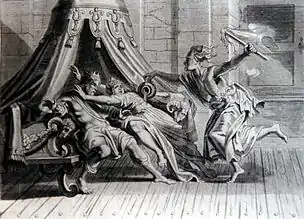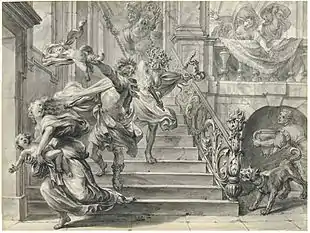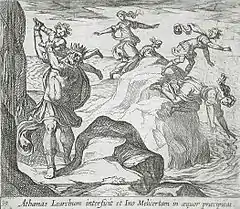Athamas
In Greek mythology, Athamas (Ancient Greek: Ἀθάμας) (/ˈæθəməs/) was a Boeotian king.[1]

Family
He was a son of Aeolus[2] and Enarete,[3] and sired several children by his first wife, the goddess Nephele, and his other wives Ino and Themisto.[4] Nephele first bore to him twins, a son Phrixus and a daughter Helle;[1] and also a second son, Makistos.[5] He subsequently married Ino, daughter of Cadmus, with whom he had two children: Learches and Melicertes.[1] By Themisto, he was the father of Sphincius and Orchomenus[2] or Schoeneus and Leucon[6] and also, Erythrius and Ptous.[7][8][9]
Mythology

Phrixus and Helle were hated by their stepmother, Ino. Ino hatched a devious plot to get rid of the twins, roasting all the town's crop seeds so they would not grow. The local farmers, frightened of famine, asked a nearby oracle for assistance. Ino bribed the men sent to the oracle to lie and tell the others that the oracle required the sacrifice of Phrixus. Athamas reluctantly agreed. But, before Phrixus could be killed, he and Helle were spirited away by a flying golden ram sent by Nephele, their natural mother. Helle fell off the ram into the Hellespont (which was named after her) and died, but Phrixus survived all the way to Colchis, where King Aeëtes took him in and treated him kindly, giving Phrixus his daughter Chalciope in marriage. In gratitude, Phrixus gave the king the golden fleece of the ram, which Aeëtes hung in a tree in his kingdom.[1]

Later, Ino raised Dionysus, her nephew, son of her sister Semele, causing Hera's intense jealousy. In vengeance, Hera struck Athamas with insanity. Athamas went mad and slew one of his sons, Learchus; Ino, to escape the pursuit of her frenzied husband, threw herself into the sea with her son Melicertes. Both were afterwards worshipped as marine divinities, Ino as Leucothea, Melicertes as Palaemon.[10]
Athamas, with the guilt of his son's murder upon him, was obliged to flee from Boeotia. He was ordered by the oracle to settle in a place where he should receive hospitality from wild beasts. This he found at Phthiotis in Thessaly, where he surprised some wolves eating sheep; on his approach they fled, leaving him the bones. Athamas, regarding this as the fulfilment of the oracle, settled there and married a third wife, Themisto (sons: Schoeneus, Leucon, Ptous and/or others). The spot was afterwards called the Athamanian plain. When Athamas returned to his second wife, Ino, Themisto sought revenge by dressing her children in white clothing and Ino's in black. Ino switched their clothes without Themisto's knowledge, and she killed her own children.[10]
According to some accounts, Athamas was succeeded on the throne by Presbon.[11] A part of Kingdom of Athamas, and himself, moved west north and took roots in a part of Pindus mountains in Epirus, called Athamanean mountains. So this population today is called Athamaneans.
Gallery
 Atamante preso dalle Furie by Arcangelo Migliarini (1801) at Roma, Accademia di San Luca
Atamante preso dalle Furie by Arcangelo Migliarini (1801) at Roma, Accademia di San Luca.jpg.webp) Athamas tue le fils d'Ino by Gaetano Gandolfi (1801)
Athamas tue le fils d'Ino by Gaetano Gandolfi (1801) Athamas und Ino by Radierung (17th century)
Athamas und Ino by Radierung (17th century) The Insane Athamas Killing Learchus, While Ino and Melicertor Jump into the Sea by Wilhelm Janson (Holland, Amsterdam), Antonio Tempesta (Italy, Florence, 1555-1630) at Los Angeles County Museum of Art, Los Angeles
The Insane Athamas Killing Learchus, While Ino and Melicertor Jump into the Sea by Wilhelm Janson (Holland, Amsterdam), Antonio Tempesta (Italy, Florence, 1555-1630) at Los Angeles County Museum of Art, Los Angeles
Notes
| Wikimedia Commons has media related to Athamas. |
- Pseudo-Apollodorus, Bibliotheca 1.9.1
- Hyginus, Fabulae 1
- Compare Hesiod, Catalogue of Women fr. 10(a)25–6 & Pseudo-Apollodorus, Bibliotheca 1.7.3
- Pseudo-Apollodorus, Bibliotheca 1.9.1-2
- Edmunds, Lowell (2015). "Early Greek Mythography. Volume 2: Commentary by Robert L. Fowler". Classical World. 108 (2): 303–304. doi:10.1353/clw.2015.0005. ISSN 1558-9234.
- Nonnus, Dionysiaca, 9. 314
- Pseudo-Apollodorus, Bibliotheca 1.9.2.
- Scholia on Apollonius Rhodius, Argonautica, 2. 1144: it appears that the scholiast believed her to be mother of Phrixus and Helle as well.
- Tzetzes on Lycophron, 22
- Ovid. Metamorphoses, 4.416
- Presbon Archived 2007-09-02 at the Wayback Machine
References
- Hesiod, Catalogue of Women from Homeric Hymns, Epic Cycle, Homerica translated by Evelyn-White, H G. Loeb Classical Library Volume 57. London: William Heinemann, 1914. Online version at theio.com
- Pseudo-Apollodorus, The Library with an English Translation by Sir James George Frazer, F.B.A., F.R.S. in 2 Volumes, Cambridge, MA, Harvard University Press; London, William Heinemann Ltd. 1921. Online version at the Perseus Digital Library. Greek text available from the same website.
- Publius Ovidius Naso, Metamorphoses translated by Brookes More (1859-1942). Boston, Cornhill Publishing Co. 1922. Online version at the Perseus Digital Library.
- Publius Ovidius Naso, Metamorphoses. Hugo Magnus. Gotha (Germany). Friedr. Andr. Perthes. 1892. Latin text available at the Perseus Digital Library.
External links
- Images of Athamas and Ino in the Warburg Institute Iconographic Database